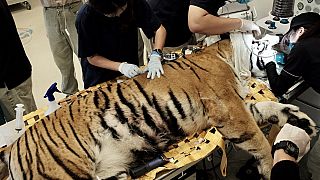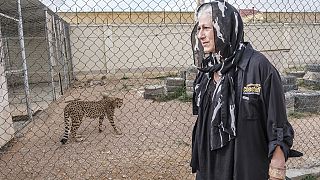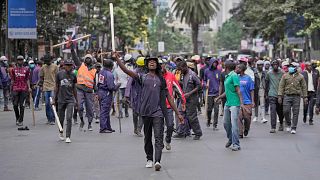South Africa
South Africa is flying cheetahs to India and Mozambique as part of ambitious efforts to reintroduce the distinctively spotted cats in regions where their population has dwindled.
Calmly seated in their enclosures, the mammals were in quarantine for about a month before getting clearance for travel.
The distinctively spotted cats that once roamed in Asia was declared extinct in India in 1952. Since then, the country turned to Iran and to Africa as part of efforts to reintroduce the feline.
"**Namibia is making 8 animals available for reintroduction in India and South Africa is making 12 animals available, but for a genetically viable population in India in the long term, you need at least 500 individuals,**Vincent van der Merwe, Cheetah Metapopulation Initiative Manager explains.So we are going to send, every year we'll send 8-12 animals to top them up, to increase their numbers, to bring in new genetics until they have a viable population."
South Africa's cheetah population is expanding at a rate of about 8% annually. Other quarantined animal at the Rooiberg Wildlife Veterinary Park are destined for Mozambique where their population has dwindled. Before their journey, a delicate capture phase begins. The cats are sedated, their identification collars checked and they are finally loaded into a vehicle.
This phase also serves as practise especially for the veterinary team. Indeed, 12 more cheetahs will be sent to India in October. This larger and more challenging relocation will require the cats to travel longer distances with stops in commercial airports.
"It's a lot better to have a smaller cage than a bigger one, or like a crate, and that's purely because it doesn't give them (cheetahs) space to try and run against the sides to get out, Robyn Keyes, a veterinary assistant says. But the stress level is the biggest thing, so after they've been woken up they (we) usually use a long-lasting anaesthetic which comes out of the system quite slowly as opposed to other opioids which you can reverse and then they'll be completely awake and very stressed."
New environnement
This time was a sucess, the South African cheetahs are ready for their trip.
"We immobilised 4 cheetahs, 2 adult males and 2 adult females, and we've loaded them into transport crates and they will be travelling to Marromeus (National Reserve) in the Zambezi Delta in Mozambique, Andy Frasier, another veterinarian at Rooiberg Wildlife Veterinary Park adds. So Vincent van der Merwe (Manager of Cheetah Metapopulation) will be travelling with the cats through the night. They will then hop onto an airplane and travel over into Mozambique early in the morning."
The southern African countries of South Africa, Zambia, Namibia and Zimbabwe have significant cheetah populations and are expected to play a part in their reintroduction in India following the first shipments this year. The plan is for the cats to be kept in large enclosures in central Indian forests, protected from other predators like leopards, to give them time to adapt to their new habitat.
The enclosures have prey — like deer and antelope — which scientists hope the cheetahs will hunt. After a few months of close monitoring, the cheetahs will be radio-collared and released.
Indian officials say the move will aid global cheetah conservation efforts.













Go to video
Former South African deputy president David Mabuza dies at 64
01:45
From Uganda to NYC: Zohran Mamdani's rise in American politics
Go to video
African gut study reveals urbanization threatens microbial diversity
01:35
Edgar Lungu's family condemns court decision to stop private burial in South Africa
00:52
South African court halts burial of Zambia’s ex-president Edgar Lungu